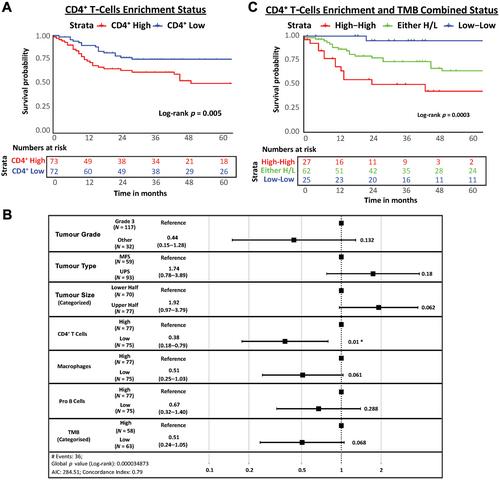Transcriptomic profiles of myxofibrosarcoma and undifferentiated pleomorphic sarcoma correlate with clinical and genomic features
Shamik Mitra, Akanksha Farswan, Paul Piccinelli, Saskia Sydow, Asle Hesla, Panagiotis Tsagkozis, Fredrik Vult von Steyern, Martin Almqvist, Mikael Eriksson, Linda Magnusson, Jenny Nilsson, Nischalan Pillay, Fredrik Mertens
下载PDF
{"title":"Transcriptomic profiles of myxofibrosarcoma and undifferentiated pleomorphic sarcoma correlate with clinical and genomic features","authors":"Shamik Mitra, Akanksha Farswan, Paul Piccinelli, Saskia Sydow, Asle Hesla, Panagiotis Tsagkozis, Fredrik Vult von Steyern, Martin Almqvist, Mikael Eriksson, Linda Magnusson, Jenny Nilsson, Nischalan Pillay, Fredrik Mertens","doi":"10.1002/path.6347","DOIUrl":null,"url":null,"abstract":"<p>Myxofibrosarcoma (MFS) and undifferentiated pleomorphic sarcoma (UPS) are two common and aggressive subtypes of soft tissue sarcoma. The aim of this study was to assess potential transcriptomic differences between MFS and UPS tumours and to evaluate the extent to which differences in gene expression profiles were associated with genomic and clinical features. The study included 162 patients with tumours diagnosed as MFS (<i>N</i> = 62) or UPS (<i>N</i> = 100). The patients had been diagnosed and treated at two Swedish sarcoma centres during a 30-year period. For gene expression profiling and gene fusion detection all tumours were analysed using RNA-sequencing and could be compared with data on clinical outcome (<i>N</i> = 155), global copy number profiles (<i>N</i> = 145), and gene mutations (<i>N</i> = 128). Gene expression profiling revealed three transcriptomic clusters (TCs) without any clear separation of MFS and UPS. One TC was associated with longer metastasis-free survival. These tumours had lower tumour mutation burden (TMB), were enriched for a copy number signature representative of focal LOH and chromosomal instability on a diploid background, and were relatively immune-depleted. MFS and UPS showed extensive genomic overlap, with whole genome doubling occurring more frequently among the latter. The results support the idea that MFS and UPS tumours have largely overlapping genomic and transcriptomic features, with UPS tumours showing more aggressive behaviour and more complex genomes. Independently of the tumour type, clinically relevant subgroups were revealed by gene expression analysis, and the finding of multiple genomic subgroups strongly suggest the existence of subgroups of relevance to treatment stratification. © 2024 The Author(s). <i>The Journal of Pathology</i> published by John Wiley & Sons Ltd on behalf of The Pathological Society of Great Britain and Ireland.</p>","PeriodicalId":232,"journal":{"name":"The Journal of Pathology","volume":"264 3","pages":"293-304"},"PeriodicalIF":5.6000,"publicationDate":"2024-09-11","publicationTypes":"Journal Article","fieldsOfStudy":null,"isOpenAccess":false,"openAccessPdf":"https://onlinelibrary.wiley.com/doi/epdf/10.1002/path.6347","citationCount":"0","resultStr":null,"platform":"Semanticscholar","paperid":null,"PeriodicalName":"The Journal of Pathology","FirstCategoryId":"3","ListUrlMain":"https://onlinelibrary.wiley.com/doi/10.1002/path.6347","RegionNum":2,"RegionCategory":"医学","ArticlePicture":[],"TitleCN":null,"AbstractTextCN":null,"PMCID":null,"EPubDate":"","PubModel":"","JCR":"Q1","JCRName":"ONCOLOGY","Score":null,"Total":0}
引用次数: 0
引用
批量引用
Abstract
Myxofibrosarcoma (MFS) and undifferentiated pleomorphic sarcoma (UPS) are two common and aggressive subtypes of soft tissue sarcoma. The aim of this study was to assess potential transcriptomic differences between MFS and UPS tumours and to evaluate the extent to which differences in gene expression profiles were associated with genomic and clinical features. The study included 162 patients with tumours diagnosed as MFS (N = 62) or UPS (N = 100). The patients had been diagnosed and treated at two Swedish sarcoma centres during a 30-year period. For gene expression profiling and gene fusion detection all tumours were analysed using RNA-sequencing and could be compared with data on clinical outcome (N = 155), global copy number profiles (N = 145), and gene mutations (N = 128). Gene expression profiling revealed three transcriptomic clusters (TCs) without any clear separation of MFS and UPS. One TC was associated with longer metastasis-free survival. These tumours had lower tumour mutation burden (TMB), were enriched for a copy number signature representative of focal LOH and chromosomal instability on a diploid background, and were relatively immune-depleted. MFS and UPS showed extensive genomic overlap, with whole genome doubling occurring more frequently among the latter. The results support the idea that MFS and UPS tumours have largely overlapping genomic and transcriptomic features, with UPS tumours showing more aggressive behaviour and more complex genomes. Independently of the tumour type, clinically relevant subgroups were revealed by gene expression analysis, and the finding of multiple genomic subgroups strongly suggest the existence of subgroups of relevance to treatment stratification. © 2024 The Author(s). The Journal of Pathology published by John Wiley & Sons Ltd on behalf of The Pathological Society of Great Britain and Ireland.
肌纤维肉瘤和未分化多形性肉瘤的转录组特征与临床和基因组特征的关系
肌纤维肉瘤(MFS)和未分化多形性肉瘤(UPS)是两种常见的侵袭性软组织肉瘤亚型。本研究旨在评估 MFS 和 UPS 肿瘤之间潜在的转录组差异,并评估基因表达谱的差异与基因组和临床特征的关联程度。研究纳入了162名被诊断为MFS(62人)或UPS(100人)的肿瘤患者。这些患者在30年间在瑞典的两个肉瘤中心接受了诊断和治疗。为了进行基因表达谱分析和基因融合检测,所有肿瘤都使用 RNA 测序进行了分析,并可与临床结果(155 例)、全局拷贝数图谱(145 例)和基因突变(128 例)的数据进行比较。基因表达谱分析发现了三个转录组群(TC),但没有明确区分 MFS 和 UPS。其中一个转录组与较长的无转移生存期相关。这些肿瘤的肿瘤突变负荷(TMB)较低,富含代表二倍体背景上局灶LOH和染色体不稳定性的拷贝数特征,而且免疫功能相对低下。MFS 和 UPS 显示出广泛的基因组重叠,后者的全基因组加倍更为频繁。研究结果支持这一观点,即MFS和UPS肿瘤的基因组和转录组特征在很大程度上重叠,UPS肿瘤的侵袭性更强,基因组更复杂。基因表达分析揭示了与肿瘤类型无关的临床相关亚组,多个基因组亚组的发现有力地表明存在与治疗分层相关的亚组。© 2024 作者。病理学杂志》由 John Wiley & Sons Ltd 代表大不列颠及爱尔兰病理学会出版。
本文章由计算机程序翻译,如有差异,请以英文原文为准。




